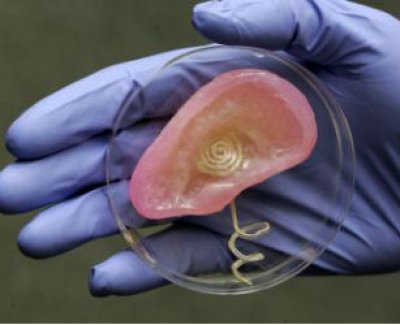3D Printed Bionic Ear
Princeton University scientists have used 3D printers to “print” bionic ears with the potential to hear frequencies that an unaugmented human ear cannot pick up. The team’s 3D printer interweaves a hydrogel matrix of calf cartilage cells with conductive silver nanoparticles to form the ear’s structure. Deposited silicone covers the inductive coil antenna which in turn connects to “cochlear-like electrodes.”
The team’s primary goal was to discover the most effective, versatile, and efficient techniques for intricately merging nanoelectronics with biological tissue.
The printed ear could allow a person to hear by outputting a signal via wire that interfaces with auditory nerves. The Princeton team explains that the ears “exhibit enhanced auditory sensing for radio frequency reception, and complementary left and right ears can listen to stereo audio music.”
This bionic ear is particularly exciting in that it may represent the first cybernetic organ with capabilities beyond those of unaugmented humans. It is also a legitimate showcase for the potential of 3D printing technology. This bionic ear, however, is potentially an even more significant harbinger as it represents the very beginnings of what many consider classic transhumanity.